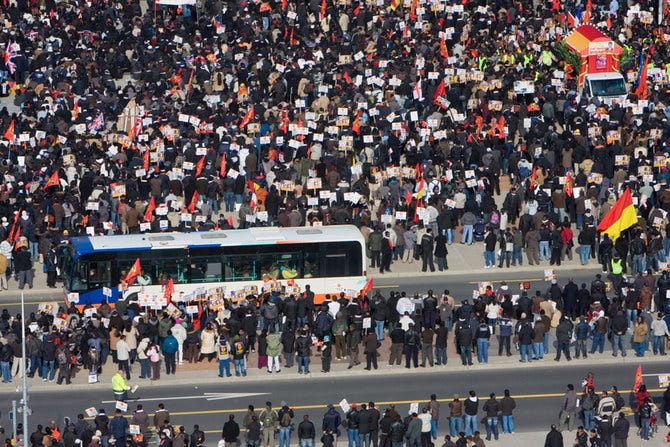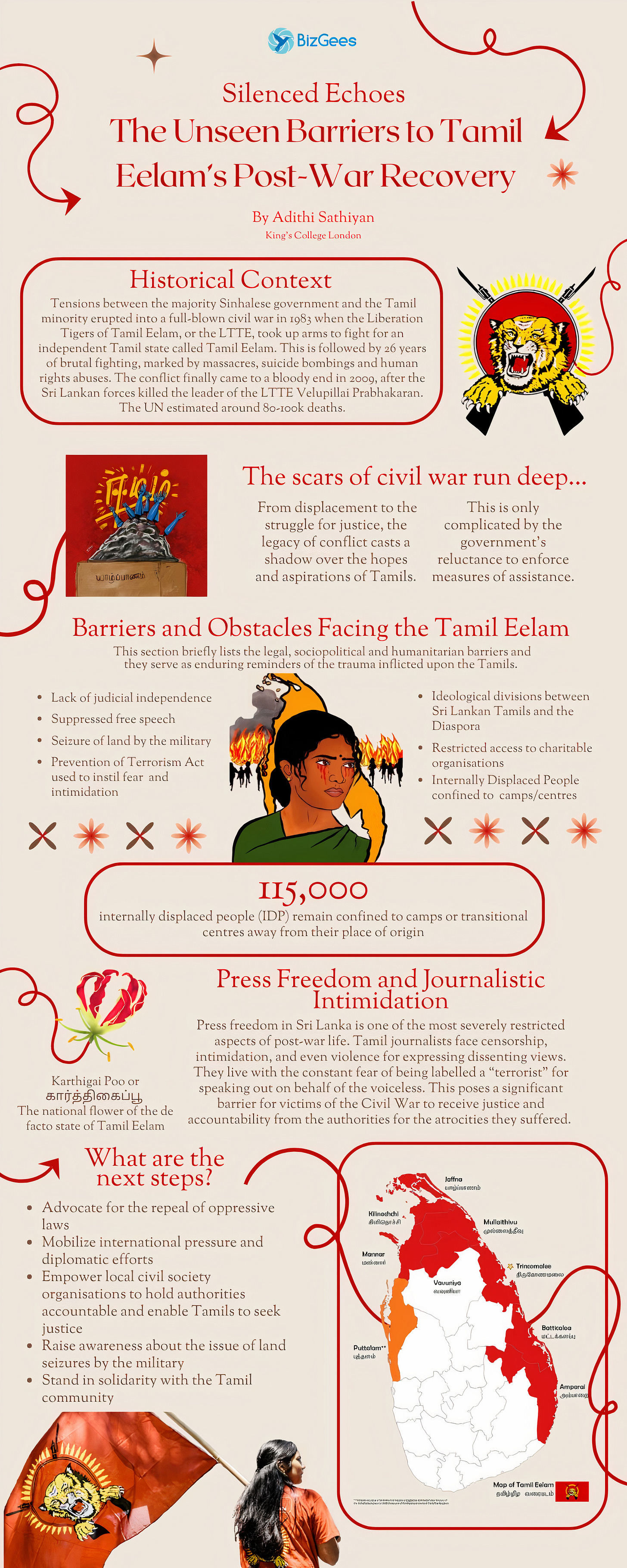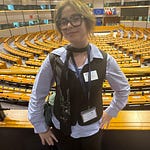Silenced Echoes: The Unseen Barriers to Tamil Eelam’s Post-War Recovery
On May 19, 2009, there came a moment of collective exhalation, a palpable release of tension as the last shots were fired and the 26-year-long sectarian conflict between the Sri Lankan armed forces and the Liberation Tigers of Tamil Eelam (LTTE) ended conclusively yet bloodily. Despite the widespread relief of much of the war-weary international community, the scars of civil conflict persist as enduring reminders of the trauma inflicted upon Tamil Eelam, marked by extrajudicial massacres, targeted suicide bombings of key political figures, and widespread detentions. Fifteen years on, countless barriers continue to plague this vulnerable population, casting a long shadow over their hopes for a future free from the shackles of hostility and oppression.
After the Sri Lankan Civil War, Tamils often find themselves entangled in a web of legal, economic, and socio-political obstacles that hinder their path to recovery and reconciliation. Many barriers loom large, but the most significant one is the lack of transitional justice mechanisms, influenced by the overwhelming pro-Sinhalese political influence in the judiciary. Speaking out against state-sanctioned abuses of power towards ethnic minorities, notably among human rights activists, lawyers, and political opponents, is met with a severe crackdown marked by physical attacks, death threats, and arbitrary detention. This almost omnipresent atmosphere of fear and intimidation raises concerns about the extent to which the fundamental human need for self-determination and autonomy within the Tamil community is compromised.
Press freedom, once a beacon of democracy, remains under siege. Strict media regulations, purportedly aimed at ‘protecting government interests’ from ‘unethical reporting,’ merely strangle online and offline news outlets. Meanwhile, journalists lament the suppression of voices critical of the establishment. Consequently, the public's access to information is severely restricted, with heavily biased reports from state-controlled media dominating the narrative landscape. This monopoly on news not only skews perspectives but also stifles open discourse on crucial matters, posing a significant obstacle to the democratisation of post-war Sri Lanka.
The government of Sri Lanka has also resorted to drastic measures such as website blocks and frequent raids on media offices, posing a significant threat of media censorship. According to the media advocacy group 'Networking for Rights in Sri Lanka', the government has progressively restricted access to information since June 19, 2007. It started by preventing access to TamilNet, a prominent news and opinion website covering Tamil issues, followed by blocking dozens of other news sites advocating for minority rights. In a more chilling demonstration of assaults on press freedom, Tamil Eelam has witnessed targeted killings of at least 41 Tamil media workers, allegedly by state actors or paramilitaries. Similarly, the haunting occurrence of attacks using petrol bombs on the offices of Maharajah Television stations in Pannipitiya serves as a stark reminder of the dangerous environment in which journalists operate in the country.
The government’s continuous refusal to repeal the oppressive Prevention of Terrorism Act (PTA) is fueling the palpable suppression of free speech within the island, despite the frequent introduction of new bills. The sweeping powers of this draconian legislation allow courts to accept any statement made by the accused as evidence, regardless of its origin, even if extracted under conditions of torture and coercion. Additionally, the glaring lack of robust witness protection laws and the widely reported lack of independence of the National Human Rights Commission further hinder efforts for accountability. In this environment, a culture of impunity thrives, perpetuating a cycle of injustice and denying closure to the numerous victims and families who bore the brunt of the Civil War's atrocities.
Yet, the issue of ideological divisions transcends the Sinhalese and Eelam Tamil communities; a similar divide emerges between the Tamils remaining in Sri Lanka and their counterparts scattered across the globe, ranging from Canada and the U.K. to Malaysia. The Tamils in Sri Lanka, exhausted by decades of war, long to return to a stable and conflict-free life and therefore prioritise rebuilding their lives within a unified nation alongside significant reforms to foster progress and inclusivity. Their reluctance to engage in armed struggle is in stark contrast to the international diaspora, where the dream of Eelam, an independent Tamil homeland, burns fervently. Their profound commitment to Tamil nationalism deepens the divide between the two groups, as leaders in the diaspora dismiss Tamil politicians in Sri Lanka as either traitors collaborating with the government or as too feeble to advocate for their own people's rights, intensifying tensions and highlighting the complexity of achieving identity, respect, and recognition for the Tamil people.
Above: Tamils from across Europe protest in Geneva, Switzerland against Sri Lanka's military offensive against Tamil rebels in February of 2009 (Shutterstock image)
Amidst the aftermath of the Sri Lankan Civil War, a lesser known but critical facet must also be explored: the plight of the internally displaced Tamils. Despite the conflict’s end, over 115,000 individuals remain confined to camps or transitional centres; many of whom were forcibly relocated against their will. For the 407,000 who have returned to their communities, challenges abound– accessing necessities such as food, water, shelter and sanitation remains difficult. Moreover, the lack of educational and employment opportunities not only complicates their reintegration but also serves as a deterrent to the displaced, casting a shadow over their hopes of returning to some form of normalcy.
However, the most pressing challenge facing the displaced is undoubtedly their struggle to reclaim land seized by the Sri Lankan military during the war, intended to establish security buffer zones around military installations and other high-value targets. Even years after the end of hostilities, much of this land remains inaccessible to its rightful owners. Facilitated by exploitative prescriptive title policies that allow individuals living on the land for over a decade to claim legal ownership and other legal loopholes, the courts continue to stall lawsuits and writ applications filed by landowners who often lost their title deeds. The already cumbersome process of reclaiming ownership is made worse by the military's view of the occupied land as economically valuable for their purposes, such as army camps and bases. This perpetuates a cycle of displacement and disempowerment for affected individuals. Shockingly, the Ministry of Relief, Rehabilitation, and Reconciliation does not recognise them as internally displaced persons (IDPs), depriving them of crucial state support. This underscores the ongoing hostilities and differential treatment faced by Tamils and other ethnic and religious minorities.
In the complex web of challenges after the war, the main obstacle to effective resettlement lies in the government's lack of political will and neglect in prioritising long-lasting solutions. Despite the potential for funding from willing donors, humanitarian organisations have to grapple with restrictions on programming and access, hindering their efforts to address the urgent needs of this vulnerable population. Meanwhile, the state's unwavering fixation on promoting return as the sole option sidelines more viable alternatives. This exclusion, combined with the prohibition of local integration in ethnically diverse regions like Trincomalee, reinforces the existing ethnic status quo. The result? Tamils are stripped of their autonomy, deprived of the right to choose where they call home and left grappling with the daunting task of rebuilding their shattered lives.
The challenging journey of Tamil Eelam towards healing and justice remains filled with obstacles, including systemic discrimination and political inertia, as well as the relentless stifling of basic rights. These obstacles remind us that the echoes of wartime repression still linger and overshadow the hopes of the beleaguered Tamil community. However, amidst the turmoil, the resilience of this vulnerable community continues to shine through the cracks of devastation. Despite facing overwhelming odds, the spirit of hope flickers in the hearts of courageous Tamil journalists who refuse to be silenced and the countless NGO workers who tirelessly strive to rebuild these devastated communities from the ground up. As we witness their struggles, let us not ignore their plight, but instead stand in solidarity, amplifying their voices and advocating for the dignity and rights that they have fought and sacrificed their lives for over the course of many years. Every 27th of November, Tamils worldwide come together to observe Maaveerar Naal (or Great Heroes' Day), a solemn occasion to honour the 50,000 Tamil lives lost during the Civil War. May this day serve as a poignant yet resolute testament to the indomitable human spirit and the unwavering pursuit of a more just and peaceful tomorrow, both for Tamils in Sri Lanka and beyond.
In this episode Adithi discusses the Tamil post conflict expereince in Sri Lanka. She is a student journalist with us on a placement organised with War Studies Department, King’s College, London. This article was edited using Lex.page.
Thank you for reading an A4R 🎨 Post. Don’t forget to visit our gift shop here. Every purchase scales our impact and pays our bills.













